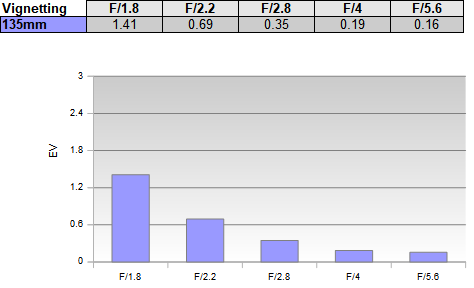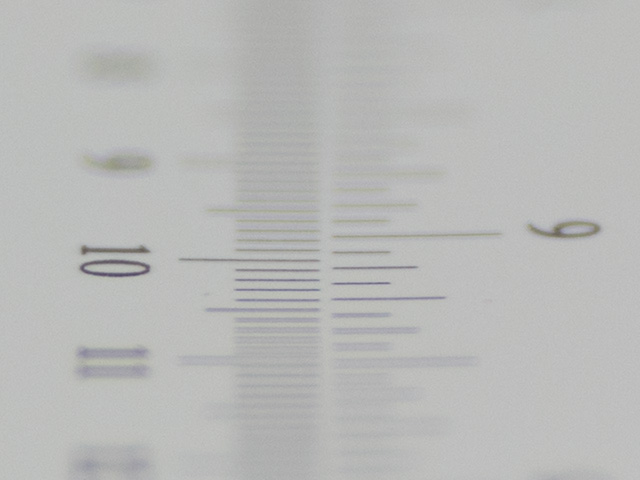|
Sigma 135mm f/1.8 DG HSM ART (Canon) - Review / Test - Analysis |
|
Lens Reviews -
Canon EOS (Full Format)
|
|
Page 2 of 3

Distortion
The Sigma 135mm f/1.8 HSM DG ART produces images that are essentially free of distortions (~0.18% pincushion distortion).

Vignetting
The vignetting characteristic is moderate for such a lens. The light falloff at fully open aperture (1.4EV) is still visible, of course, but not really obtrusive. Stopping down to f/2.2 reduces the issue substantially and it's irrelevant from f/2.8 onward.

MTF (resolution) on the EOS 5Ds R (at 50 megapixels)
Awesome. Just awesome. The Sigma lens is tack sharp in the image center at fully open aperture and the borders and far corners are very good. Stopping down increases the quality marginally but we are talking about an extremely high base level already. The technical sweet spot is at f/4 with an excellent performance across the image field. That's as good as it can get really. Diffraction has a first impact at f/8 but f/11 remains usable.
The centering quality of the tested lens was very good. The field curvature is low.
Please note that the MTF results are not directly comparable across the different systems!
Below is a simplified summary of the formal findings. The chart shows line widths per picture height (LW/PH) which can be taken as a measure for sharpness.
If you want to know more about the MTF50 figures you may check out the corresponding Imatest Explanations

Chromatic Aberrations (CAs)
The outstanding resolution is accompanied by a very low CAs (chromatic aberrations) with an average pixel width of less than 0.5px at the image borders.

Bokeh
Sharpness is one thing but blur is another one. If you go for such a fast lens, you do it primarily for its shallow depth-of-field capabilities so let's have a look at the "bokeh" (rendition of the out-of-focus blur).
Below are crops taken in the focus transitions zones just in front and behind the actual focus point. The blur is perfectly symmetrical. If we are nit-picky, we may argue that harsh contrasts are not perfectly smooth but there are few lenses (other than STFs) capable of rendering this better.
 Out of focus highlights are very nicely rendered. The inner discs are very even and the discs show virtually no outlining from f/1.8 to f/2.8. The outlining gets a little more apparent at f/4 (but then who cares about this at f/4).
Out of focus highlights are very nicely rendered. The inner discs are very even and the discs show virtually no outlining from f/1.8 to f/2.8. The outlining gets a little more apparent at f/4 (but then who cares about this at f/4).
 That being said, the discs deteriorate towards the image corners (cat’s eyes). This is a vignetting effect and as unfortunate as it may be it affects all full format lenses (when used on full format cameras). The crop below illustrates the "worst" spot in the far corners.
That being said, the discs deteriorate towards the image corners (cat’s eyes). This is a vignetting effect and as unfortunate as it may be it affects all full format lenses (when used on full format cameras). The crop below illustrates the "worst" spot in the far corners.
 Stopping down reduces the effect - below is the same crop taken at f/2.8.
Stopping down reduces the effect - below is the same crop taken at f/2.8.
 If you are into "bubble making" ... here's a real world scene which shows you what the lens can give you there ...
If you are into "bubble making" ... here's a real world scene which shows you what the lens can give you there ...

Bokeh Fringing
In a perfect world scenario, you won’t see any axial CAs thus color fringing on the Z-axis. However, axial CAs are extremely difficult to correct and only a handful of lenses are capable of managing this. The Sigma 135mm f/1.8 HSM DG ART shows a comparatively low amount of axial CAs but you can spot them at large aperture settings - there are purplish traces in front of the focus point and greenish traces beyond. Stopping down reduces the color fringing but it remains visible till at least f/4.
If you scroll through the aperture range you may also spot that the focus point remains constant - thus the lens doesn't suffer from residual spherical aberrations (focus shifts).
|
Move the mouse cursor over the f-stop marks below to observe the respective LoCAs
|
| f/1.8 |
f/2.2 |
f/2.8 |
f/4 |
|

|
|